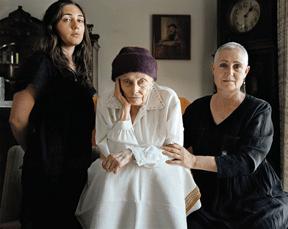
What happens when home is no longer home?
The recent flood of people seeking refuge across the globe has brought in its wake a surge of interest in the personal and communal effects of migration. As a social anthropologist and world-acclaimed photographer, Frédéric Brenner has been seeking answers to this question for over 30 years. His photographs are on exhibition at the Jewish Community Center through Feb. 29 and on Tuesday, Feb. 23, Brenner will share his images and observations at the Jewish Community Center. The 7 p.m. presentation, accompanied by an exhibition of his work, will be followed by a book signing and reception. The cost of Brenner’s presentation, exhibition and reception is $18 per person in advance and $22 at the door.
For 25 years, Brenner visited more than 40 countries, initially seeking to create a record of vanishing Jewish communities before they disappeared. Ultimately, his project became a probing pursuit of widely disparate practices, rituals and communal institutions. The stunning images in his resulting opus Diaspora challenge the existence of Jews as one people, beg the definition of Jewish culture and question whether that culture is evaporating.
The J’s Director of Jewish Life and Learning Jill Maidhof first heard Brenner speak during an educators’ seminar in Israel over a decade ago.
“The images of Jews were captivating, but it was Brenner himself — the insights he shared and the questions he asked — that caused me to determine that someday, I would bring him to Kansas,” Maidhof said.
“Little did I know that the timing would coincide with a worldwide refugee crisis. I think that we who are privileged to live in stable societies tend to focus on how lucky others are to find safe havens and to concern ourselves with the effect of their presence on our own security,” Maidhof said. “Needless to say, these are critical issues. In sharing the Jewish experience, Brenner inspires us to think as well about the proud heritage of any population that moves from its native land. What happens to their way of dress, religion, language, sense of community and sense of self? In other words, he defines the very issues that migrant populations all over the world are wrestling with today.
In 2007, Brenner launched a major new project, “This Place,” in which he invited 11 world-renowned photographers to join him in exploring Israel as place and metaphor, to use photography as a tool to look at Israel as a living organism filled with rifts and paradoxes. In an interview with the Israeli newspaper Haaretz, Brenner said that the idea of the project is to look beyond the political narrative — not to bypass or downplay it, but to break free of the double perspective of “for” or “against”’ perpetrator or victim.
The other photographers participating in the project are Wendy Ewald, Martin Kollar, Josef Koudelka, Jungjin Lee, Gilles Peress, Fazal Sheikh, Stephen Shore, Rosalind Solomon, Thomas Struth, Jeff Wall, and Nick Waplington — a group referred by “The Financial Times” as, “the most impressive line-up of photographers in the world.” The result is a 10,000 square foot exhibition that is on a world tour and will open late in February at the Brooklyn Museum of Art. Brenner will share images from this project, as well.
In addition to his presentation at The J, Brenner will be speaking around the area to students at the Kansas City Art institute, in the Blue Valley School District’s CAPS Program, at Lincoln Academy and at the University of Kansas in the Jewish Studies program. For more information about Brenner’s presentation and visit, contact Maidhof at 913-327-8077 or by email, .



